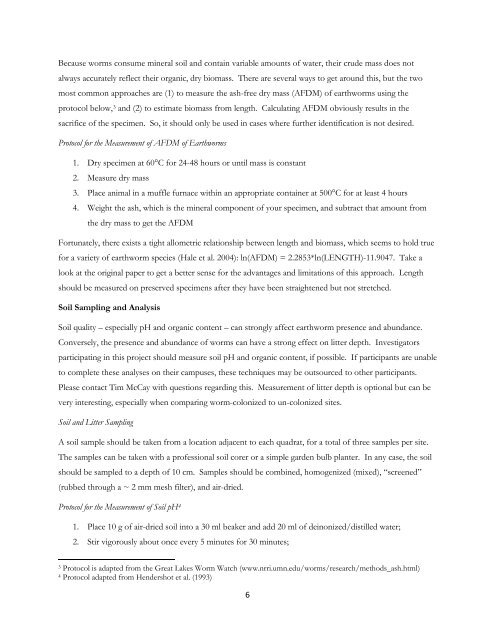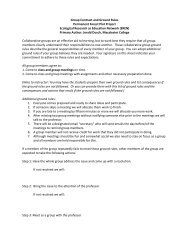EREN Worm Protocol
EREN Worm Protocol
EREN Worm Protocol
You also want an ePaper? Increase the reach of your titles
YUMPU automatically turns print PDFs into web optimized ePapers that Google loves.
Because worms consume mineral soil and contain variable amounts of water, their crude mass does not<br />
always accurately reflect their organic, dry biomass. There are several ways to get around this, but the two<br />
most common approaches are (1) to measure the ash-free dry mass (AFDM) of earthworms using the<br />
protocol below, 3 and (2) to estimate biomass from length. Calculating AFDM obviously results in the<br />
sacrifice of the specimen. So, it should only be used in cases where further identification is not desired.<br />
<strong>Protocol</strong> for the Measurement of AFDM of Earthworms<br />
1. Dry specimen at 60°C for 24-48 hours or until mass is constant<br />
2. Measure dry mass<br />
3. Place animal in a muffle furnace within an appropriate container at 500°C for at least 4 hours<br />
4. Weight the ash, which is the mineral component of your specimen, and subtract that amount from<br />
the dry mass to get the AFDM<br />
Fortunately, there exists a tight allometric relationship between length and biomass, which seems to hold true<br />
for a variety of earthworm species (Hale et al. 2004): ln(AFDM) = 2.2853*ln(LENGTH)-11.9047. Take a<br />
look at the original paper to get a better sense for the advantages and limitations of this approach. Length<br />
should be measured on preserved specimens after they have been straightened but not stretched.<br />
Soil Sampling and Analysis<br />
Soil quality – especially pH and organic content – can strongly affect earthworm presence and abundance.<br />
Conversely, the presence and abundance of worms can have a strong effect on litter depth. Investigators<br />
participating in this project should measure soil pH and organic content, if possible. If participants are unable<br />
to complete these analyses on their campuses, these techniques may be outsourced to other participants.<br />
Please contact Tim McCay with questions regarding this. Measurement of litter depth is optional but can be<br />
very interesting, especially when comparing worm-colonized to un-colonized sites.<br />
Soil and Litter Sampling<br />
A soil sample should be taken from a location adjacent to each quadrat, for a total of three samples per site.<br />
The samples can be taken with a professional soil corer or a simple garden bulb planter. In any case, the soil<br />
should be sampled to a depth of 10 cm. Samples should be combined, homogenized (mixed), “screened”<br />
(rubbed through a ~ 2 mm mesh filter), and air-dried.<br />
<strong>Protocol</strong> for the Measurement of Soil pH 4<br />
1. Place 10 g of air-dried soil into a 30 ml beaker and add 20 ml of deinonized/distilled water;<br />
2. Stir vigorously about once every 5 minutes for 30 minutes;<br />
3 <strong>Protocol</strong> is adapted from the Great Lakes <strong>Worm</strong> Watch (www.nrri.umn.edu/worms/research/methods_ash.html)<br />
4 <strong>Protocol</strong> adapted from Hendershot et al. (1993)<br />
6




